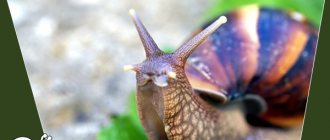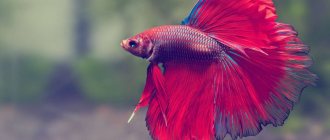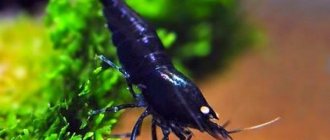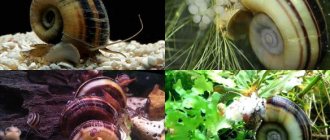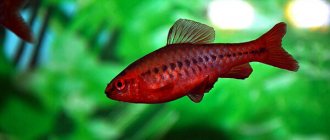Lighting
Akhatina has poor vision; she only distinguishes between day and night. Therefore, it is not necessary to install lighting in the snail's terrarium or container. This is more needed for monitoring two-horned pets and plant growth. Only the incandescent lamp needs to be taken outside the container or aquarium so that the snail does not get burned.
Temperature and humidity content
All Achatina are residents of tropical countries, so the optimal temperature for keeping them is considered to be from 24 to 28 degrees. At very high air temperatures, snails feel unwell, hibernate and may even die. There is no need to place snails on the windowsill or near the radiator.
Many snail breeders use thermal mats or a thermal cord, since the room temperature for a mollusk is very low. However, heating devices must be placed on the outside of the container. Humidity is also a prerequisite for a snail to live comfortably.
The humidity in the terrarium is maintained by daily irrigation of the soil, as well as by placing a shallow container of water. To determine humidity, a hygrometer is placed in the terrarium, but sphagnum moss can successfully replace it. If it is green and the snails are not constantly on the walls of the container, then everything is in order with humidity. If the moss turns yellow, the air needs to be humidified.
Decorating the terrarium
Branches, driftwood, pieces of bark, moss, coconut halves, etc. are used as natural materials for decorating the terrarium. I also plant indoor plants and seeds in the ground for landscaping. Snails quickly eat green shoots, thereby replenishing the body with vitamins.
However, we decorate the terrarium for ourselves; the snails do not need this for a normal life.
What to pay attention to
African giant Achatinas do not die like aquarium fish, turning over with their belly up. They can struggle for a long time to exist without showing external visible signs.
Achatina, like other species of gastropods, has a remarkable property. Under unfavorable conditions, gentle creatures hibernate. However, this does not mean that the snail is dead.
Unfavorable maintenance factors can cause the snail to not crawl out of its shell. If they are not corrected, this can cause the death of Achatina.
How the last representative of a valuable snail species died - read on.
First of all, these are low temperatures, a lack of vital elements in the diet and the general malaise of Achatina. Perhaps a sick snail is not sick or dying, but simply stressed! She reacts negatively to changes in environment and other unfavorable factors; she needs adaptation and restoration of vitality. In this case, the Achatina will close its lid and burrow into the ground and can remain in this state for 1-2 weeks. These are alarming signs that can lead to the death of Achatina.
If you encounter this situation, it does not mean that your snail is dying. Create favorable conditions in the terrarium. Tempt the snail with its favorite foods. If after several days and attempts the snail remains sealed, try buying it in warm water. These simple manipulations help save a dying hive in 95% of cases.
Check whether your pet's home meets the required standards of size, ventilation and heating, soil quality and does not contain dangerous objects and substances.
We recommend purchasing high-quality terrariums, as well as soil, heating, humidifiers and decor on the Aliexpress website. This is proven quality and good prices.
How to understand that the Achatina snail is dying?
Only daily close observation of Achatina will provide accurate and reliable information. Every day in the evening, breeders renew the food supply, pour water into the drinking bowl and watch the slow-moving creatures in the terrarium.
A dying Achatina snail does not eat, drink, or respond to external stimuli. If an individual does not move for 2-3 days, does not react to the owner and to fresh food, then the pet has big problems and perhaps they can lead to his death.
Signs of death of the Achatina snail:
- The shell is sealed with film for a long time and the pet shows no signs of life.
- When Achatina is torn from the surface or touched, it instinctively retracts its head and leg. A weakened individual, close to death, does not exhibit characteristic natural reflexes.
- The main sign of death is that the dead Achatina snail has become sealed and stinks. If the sink smells like a rotten egg, this indicates the death of a defenseless pet.
After the loss of a beloved pet, the question always arises: could the dying snail be saved?
Russian and foreign breeders of African mollusks have already accumulated extensive experience in the proper care and rescue of Achatina snails
It is important to keep a close eye on the delicate creatures and take preventative measures as needed. Let's look at the main mistakes
Cleaning at Achatina
Cleaning in the terrarium can be divided into daily and general. Every morning it is advisable to remove leftover food and feces, wash bowls, and pour clean water. Once a week, loosen the soil; if it is dirty, replace it partially with new one. Also, the snail needs to be bathed at least 1-2 times a week.
General cleaning is carried out once every 2 months. The snails are transplanted into another container. The soil is completely removed, twigs, pieces of bark, and moss are replaced. The terrarium is thoroughly washed with soda and rinsed with water. Then new soil is poured in, clean bowls with food and water are placed. Decoration at your discretion.
Often during cleaning you can come across a snail clutch. If you plan to get offspring, you need to carefully transfer the eggs into a separate container where the babies will hatch. Otherwise, freeze them and feed them to your snails or throw them in the trash.
If cleaning is not done, Achatina begins to get sick, an unpleasant odor appears, and midges and other parasites appear. If not properly cared for, the snail may go into hibernation. If this happens, clean up, then wash the Achatina with warm water. Warm water will quickly wake up the clam. Don't forget to feed well.
How to care for Achatina
A container of water is placed in the terrarium so that they can bathe. The house with shellfish should be installed away from drafts, heating devices and direct sunlight.
How to bathe Achatina
From time to time, snails need a shower. To do this, place the pet in the palm of your hand and direct a stream of water from the tap onto it. The stream should not be strong, and the water must be warm. Such procedures are carried out no more than three minutes in duration. You can watch online how the Achatina snail bathes; the video can be found without any problems.
How to treat Achatina
Like all representatives of the fauna, Achatina can get sick. They are usually affected by parasites or fungi, but can be exposed to heat or chemicals and become injured. Treatment depends on the pet's illness. Molluscum is usually treated with food. If it is affected by fungus, it is carefully washed and the sink is cleaned, sometimes using a pesticide aerosol.
What to feed the Achatina snail
Everything about the nutrition of Achatina can be divided into three components. Fiber, protein and calcium. In its natural habitat, Achatina eats plant foods, but does not refuse carrion. At home, its diet should be varied; you should not feed the snail with one type of food. Because as a result, she will develop a persistent addiction and will refuse other products.
Leaves and herbs Banana Pepper Cabbage Cucumbers Salad
Fiber is found in vegetables, fruits and greens. Achatina is unpretentious in food, so it is easier to say which vegetables and fruits snails should not eat:
- garlic;
- onion;
- hot peppers;
- raw potatoes;
- citrus;
- sour fruits.
For small Achatina, all vegetables and fruits are grated and served on lettuce leaves. As they grow older, the pieces become larger. Adult Achatina can be fed every other day, but babies need food 1-2 times a day.
Achatina snails: contents
If the Achatina snail has attracted your attention and you decide to get yourself such a pet, then along with it you will need:
Container where the snail will live
This could be an aquarium, terrarium or container, glass or plastic. Be sure to have a tight-fitting lid with small holes for ventilation. This is because the snail will escape from any open container at the first opportunity.
The volume per individual is 3 liters. For 3–5 snails, select a “house” with a capacity of 20–30 liters.
Substrate
Snails need a layer of substrate of 4–10 cm, into which they can burrow while resting and where they will lay eggs. For this purpose, at home they use:
- soil for flowers without fertilizers;
- peat;
- coconut substrate;
- loose sand;
- nut shells.
Photo: pixabay.com: UGC
Any of the substrates requires moisture, so you can experiment here. The overall humidity level in the container should be 60-70%.
If it is insufficient, the Achatina snail will hide in its shell for a long time and refuse to show itself outside. With high humidity, the pet spends all its time on the walls of the container.
Lighting
A light source is not needed in a container with snails. They should not be placed in direct sunlight. Otherwise, Achatina navigates the change of night and day on its own. During daylight hours, pets will hide in secluded corners, and at night they will behave more animatedly.
Photo: commons.wikimedia.org: UGC
Temperature
Since Achatina snails are an African species, it is important for them to live warm. The optimal temperature for their life is 20–28 °C.
Sudden temperature changes are harmful for snails, so containers with them should not be placed near heaters. A thermometer is placed in the container to make it convenient to monitor the temperature of your pets.
Decorations
To make the snail feel comfortable, build a secluded corner for it to rest from a flower pot or half a coconut.
The container will be decorated with living plants (ferns, ivy), pieces of moss, and twigs. The decor should be soft, so stones and ceramics are not suitable. Snails can damage their shells on their surface.
Photo: pixabay.com: UGC
What if there are a lot of eggs in the clutch?
The fertility of Achatina varies and one female is capable of laying an incredibly large number of eggs. If we take into account the percentage of hatching, the owner of the mollusks may face the problem of where to put such offspring . Those who have been working with giant snails for a long time recommend thinning out the clutches.
It is impossible to determine whether eggs are fertilized or not, so those that turn out to be extra need to be frozen or boiled. This is done to prevent the possibility of uncontrolled reproduction, as discarded eggs may hatch.
How to feed your pet correctly?
The diet of Achatina snails should consist exclusively of food of plant origin. In nature, these snails often eat agricultural crops, various fruit and berry trees, flowers, etc. Next, we will describe in detail useful and prohibited products for Achatina snails.
Recommended Products
Products included in a properly balanced snail diet:
- hard-boiled chicken eggs;
- tomatoes;
- bananas;
- sweet bell pepper;
- boiled potatoes;
- dairy products;
- bread;
- greenery;
- berries;
- Champignon;
- dry oatmeal;
- food for aquarium fish.
What is prohibited for consumption?
It is forbidden to feed Achatina snails with the following products:
- sweet pastries;
- pickles;
- smoked meats;
- roast;
- citrus;
- containing alcohol and any alcoholic products.
Egg care
Caring for egg-laying giant snails is very easy.
There are several rules, the observance of which contributes to the safety of eggs and the breeding of offspring:
- The eggs must remain in the substrate at all times;
- The temperature in the terrarium should not be below 28 degrees Celsius;
- should always ;
- The soil should not be allowed to dry out, nor should it be over-moistened;
- There should be no water or any other liquid under the egg laying itself, otherwise the eggs may rot.
It is not recommended to touch laid eggs with your hands. Ideally, when everything will remain as it was. You can show your intervention in the case when the eggs are laid by the female along the entire perimeter of the terrarium. This can be corrected by collecting them carefully and putting them in one place, lightly sprinkling them with substrate on top.
Mollusks appear on days 21-28 . It happens that some eggs remain unfertilized. Therefore, you should not plan in advance how many small snails will hatch. On average, about 80% of babies are produced from a clutch.
Benefits and harms
It is difficult to compare a snail as a pet with a kitten, puppy or guinea pig, but such pets have a number of undeniable advantages over any other animals:
- Does not require daily walks.
- You only need to feed once a day.
- They do not make sounds (except when eating).
- Interesting to watch.
- It can be trained by developing conditioned reflexes in mollusks.
- They can remain unattended for a long time, hibernating.
- High life expectancy up to 10 years (with proper care).
In addition to such advantages, the snail can also be useful to its owner for cosmetic and medical purposes. In order to protect their body from friction while moving, Achatina snails produce special mucus, which:
- promotes healing of the sole of the body in case of damage;
- participates in the process of repairing damage to the shell.
The properties of snail mucus are used by humans in:
- economic activity;
- folk and alternative medicine;
- cosmetology.
After lengthy scientific research, the composition of snail mucus has been carefully studied. It includes the following components:
As a result of research, it has been established that the mucus produced by snails contains the following components:
- Vitamins of groups A, S.E.
- Collagen.
- Amino acids.
- Elastin.
- Antibacterial ingredients.
- Allatonin.
The properties of snail mucus include:
- assistance in the treatment of bronchitis and other diseases of the upper respiratory tract;
- the formation of a protective cover (film) on human skin that allows oxygen to pass through and prevents moisture loss;
- hypoallergenic;
- accelerating the process of cellular regeneration;
- analgesic effect.
In cosmetology, snail mucin Achatina is used for:
- combating wrinkles around the eyes and other age-related skin changes;
- eliminating facial wrinkles;
- skin rejuvenation;
- cleansing of dead cells (peeling);
- restoring the water balance of the skin;
- skin regeneration, including after aggressive cosmetic procedures;
- lightening the skin and getting rid of pigmentation;
- treatment of scars and scars.
Achatina snails and their mucus are often used in alternative medicine for:
- treatment of postoperative scars;
- speedy healing of wounds and burns;
- eliminating cellulite and cleansing the body of accumulated heavy fats, which cannot be eliminated by traditional methods and physical exercises;
- relieving muscle spasms and tension without additional pain;
- therapy of inflammatory processes that provoke various diseases and even infertility;
- treatment of stress and diseases associated with intense mental and physical stress;
- therapy of vegetative-vascular dystonia;
- restoration of the nervous system;
- treatment of varicose veins.
Achatina snails are absolutely safe for humans, but in some cases they can cause harm:
- Mucus may contain dangerous bacteria and pathogenic microorganisms, which, if they get into open wounds, can lead to dangerous diseases.
- Despite the hypoallergenic nature of snail mucus, in some cases its use causes undesirable reactions on the skin, including angioedema.
- Eating shellfish meat can also cause allergies.
Considering that Achatina are purchased mainly from breeders and bred in captivity, they are not carriers of dangerous tropical diseases.
Treatment with Achatina at home
The medicinal properties of Achatina snails have been valued since the time of Hippocrates. Their meat has long been used to treat anemia and other diseases. And mucus was used for burns and non-healing wounds. The benefits of giant snails are such that farms began to be created to grow them after World War II. Now shellfish are successfully used to combat cellulite, varicose veins, and psoriasis.
Achatina against cellulite
Thanks to the effect of snail secretions, the skin becomes smooth and clean. This property is used to combat cellulite. If you treat problem areas of the body correctly and do not exceed the permissible number of procedures, then they will not cause any harm.
Dealing with orange peel with snail mucin is easy. Visible effect can be achieved within one month
It is important to perform anti-cellulite massage regularly, three times a week. He won't do any harm
During the procedures, snails are placed on a problem area, such as the stomach or thighs. The exposure continues for 15 minutes.
Achatina in the fight against varicose veins
The healing properties of massage help fight varicose veins. Before carrying out the procedure, thoroughly clean the areas that will be exposed. The snail is also washed under running water, after which it is placed on the body and allowed to move. After 10-15 minutes, the procedure is completed, and the remaining mucus is rubbed into the skin with massage movements for 15-20 minutes. The remains of the healing substance are washed off with water.
Treatment of psoriasis with snails
The beneficial effects of the substance secreted by snails on human skin are used to treat psoriasis. People who suffer from this disease are advised to keep these creatures as pets. While observing them, the nervous system relaxes and stressful conditions are alleviated. But the main benefit is the effect on rashes. Cosmetologists advise putting Achatina on them every day. Snail massage has the ability to relieve flaking and dryness and accelerate regenerative processes. For those who experience discomfort from touching snails, you can collect the substance they produce and rub it into the affected areas of the body.
Reproduction
The African snail Achatina reproduces easily and willingly in captivity. This species is hermaphrodite and produces offspring without a sexual partner. In the body of the mollusk, male and female cells are formed in turn, after which fertilization occurs, and the pet lays eggs that look like a smaller copy of chicken eggs. If the owner of the terrarium does not plan to have small Achatina snails, then the eggs are washed off. If there is a desire, then the Achatina snail eggs are left.
Newborn mollusks have a large appetite, so they are constantly supplied with fresh lettuce or cabbage leaves, which the babies eat and use as shelter. Grated carrots or porridge with calcium are also given as food for good growth and development. Babies reach the size of an adult fulika at 1.5 years. Little Achatina does not require special care and supervision - they are completely independent. There is no need to separate the babies from their parents, because they need waste from adult snails to develop.
How long does it take for the eggs to hatch?
After mating of the female and male snails has occurred, Achatina begins a period of pregnancy, ending with the laying of eggs . Today, all types of giant snails are oviparous with different gestation periods.
Basically, the snail lays eggs directly into the substrate. In some cases, the female may dig a shallow hole and then cover it with soil. In total, Achatina is capable of laying a large number of eggs at a time, reaching several hundred.
The average time from the start of mating to the hatching of eggs is about 45 days .
Snail diseases and shell injuries
If the rules of care and maintenance are followed, Achatina is rarely susceptible to disease. External symptoms will help determine that your pet is sick:
- apathy, lethargy;
- refusal to eat;
- blockage of the entrance to the shell;
- excessively copious or thick mucus;
- pronounced separation of the shell;
- if Achatina is in pain or scared, it is capable of emitting whistling-hissing screams that cannot be ignored.
A terrible sign is considered to be the snail falling out of its shell, resulting in its rapid death. How Achatina die depends on the cause of death. A severely weakened mollusk is identified by the absence of reflexes - when touched, it instinctively does not pull its head and body into the shell. If the shell is sealed for a long time and the pet cannot be awakened, this may also indicate that it is dead. The main sign of death is that a dead snail emits an unpleasant rotten egg smell. However, if it dies during prolonged hibernation, it may be absent, since the body becomes liquid.
The causes of Achatina diseases are:
- hypothermia or overheating of the pet;
- cramped terrarium, dry or excessively wet filler;
- infrequent cleaning of the aquarium, lack of hygienic water procedures for the snail;
- accumulation of food debris, excrement, mold in Achatina’s home;
- consumption of “harmful” foods, low-calorie and monotonous diet with insufficient amounts of calcium and protein;
- lack of ventilation, poor quality filler.
As a result of the influence of the listed factors, exposure of the snail to carcinogens, infections, fungi, parasites, etc., its health condition worsens. To treat shellfish and eliminate pathogenic microorganisms, iodine, the medicine “Mikoseptin”, and ointment with propolis are used. If you follow the correct diet, measures for cleaning the terrarium and other conditions for keeping your pet, the risk of disease is minimized.
A common problem in Achatina is the violation of the integrity of the shell. The snail may fall if moved or handled carelessly. Minor damage is lubricated with an antiseptic. If the shell is broken or cracked, breeders repair the defect using epoxy glue. If traumatized, the snail must be placed separately from other individuals, since they like to rub their shells.
Attention! It is important to provide a diet rich in calcium. This will speed up the wound healing process in the pet’s body.
To avoid injury due to careless handling, the owner must follow a number of rules:
- pick up the pet with clean and wet hands and do not use any chemicals on them: soap, cream, etc.;
- You should not forcibly tear the mollusk from the walls of the terrarium or squeeze it - this can damage the shell and internal organs;
- take the pet carefully under the sole, and not by the shell.
Characteristics
The size of adult snails ranges from 50-100 mm, although there are individual specimens whose size is 20 cm or even more. The snail has a conical shell twisted counterclockwise.
In adult individuals, the shells differ in seven to nine turns, and their color largely depends on the habitat, including diet. Despite such factors, the main color of the shells is yellowish with reddish-brown stripes.
